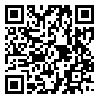Volume 79, Issue 7 (October 2021)
Tehran Univ Med J 2021, 79(7): 546-555 |
Back to browse issues page
Download citation:
BibTeX | RIS | EndNote | Medlars | ProCite | Reference Manager | RefWorks
Send citation to:



BibTeX | RIS | EndNote | Medlars | ProCite | Reference Manager | RefWorks
Send citation to:
Sofi-Mahmudi A, Shamsoddin E, Mesgarpour B, Akhondzadeh S, Kabiri P. Investigating gender differences in research performance of Iranian medical faculty members: a scientometric study. Tehran Univ Med J 2021; 79 (7) :546-555
URL: http://tumj.tums.ac.ir/article-1-11364-en.html
URL: http://tumj.tums.ac.ir/article-1-11364-en.html
1- Cochrane Iran Associate Centre, National Institute for Medical Research Development (NIMAD), Tehran, Iran.
2- Psychiatric Research Center, Tehran University of Medical Sciences, Tehran, Iran.
3- Department of Biostatistics, School of Public Health, Tehran University of Medical Sciences, Tehran, Iran.
2- Psychiatric Research Center, Tehran University of Medical Sciences, Tehran, Iran.
3- Department of Biostatistics, School of Public Health, Tehran University of Medical Sciences, Tehran, Iran.
Abstract: (1804 Views)
Background: Gender differences in scientometric indicators among medical faculty members in Iran was investigated.
Methods: The Research performance of the faculty at all universities and institutes of medical sciences in Iran was assessed using the Iranian Scientometric Information Database (ISID) on June 12, 2021. Selected variables in our study were name, gender, university, degree, academic rank, type of faculty, the total number of articles, the total number of citations, self-citation percentage, h-index, citation per article, international cooperation percentage, and the number of research collaborators. The Kruskal-Wallis test was used. The extracted data were analyzed using R v4.0.1 statistical software.
Results: A total of 21064 faculty members in 77 universities and institutes of medical sciences were registered in the ISID database, of which 12093 (57.4%) were men. Men faculty members outnumbered women in all academic ranks, except for the “instructor” rank (1134 female instructors against 835 male). In both sexes, most faculty members were assistant professors. There were more articles (346837 vs. 146024) and citations (5177060 vs. 1639246) by men than women. Among the 1789 faculty members with zero articles, 902 (50.4%) were men. One-hundred-and-fifty-four people were among ESI's top researchers' list, with a majority of men (124 people equal to 80.5%). The medians of all the scientometric indicators were higher in men than women. Men had a higher number of articles, the number of citations, h-index, citation per article, percentage of international articles, and co-authors, however, women had lower self-citations (1.56% vs. 2.51%). In all academic ranks, men had higher scientometric indicators. The only exception was the associate professors’ self-citation, in which women’s citations were higher than that of men (3.5 vs. 3.3). The highest mean h-index was in men with a Ph.D. in Pharmacy (13), men with a Ph.D. by Research (12) and women with a Ph.D. by Research (8.5), respectively.
Conclusion: Gender differences were evident in research performance in Iran. Women faculty members of medical sciences in Iran generally had lower scientometric indicators.
Methods: The Research performance of the faculty at all universities and institutes of medical sciences in Iran was assessed using the Iranian Scientometric Information Database (ISID) on June 12, 2021. Selected variables in our study were name, gender, university, degree, academic rank, type of faculty, the total number of articles, the total number of citations, self-citation percentage, h-index, citation per article, international cooperation percentage, and the number of research collaborators. The Kruskal-Wallis test was used. The extracted data were analyzed using R v4.0.1 statistical software.
Results: A total of 21064 faculty members in 77 universities and institutes of medical sciences were registered in the ISID database, of which 12093 (57.4%) were men. Men faculty members outnumbered women in all academic ranks, except for the “instructor” rank (1134 female instructors against 835 male). In both sexes, most faculty members were assistant professors. There were more articles (346837 vs. 146024) and citations (5177060 vs. 1639246) by men than women. Among the 1789 faculty members with zero articles, 902 (50.4%) were men. One-hundred-and-fifty-four people were among ESI's top researchers' list, with a majority of men (124 people equal to 80.5%). The medians of all the scientometric indicators were higher in men than women. Men had a higher number of articles, the number of citations, h-index, citation per article, percentage of international articles, and co-authors, however, women had lower self-citations (1.56% vs. 2.51%). In all academic ranks, men had higher scientometric indicators. The only exception was the associate professors’ self-citation, in which women’s citations were higher than that of men (3.5 vs. 3.3). The highest mean h-index was in men with a Ph.D. in Pharmacy (13), men with a Ph.D. by Research (12) and women with a Ph.D. by Research (8.5), respectively.
Conclusion: Gender differences were evident in research performance in Iran. Women faculty members of medical sciences in Iran generally had lower scientometric indicators.
Type of Study: Original Article |
| Rights and permissions | |
 |
This work is licensed under a Creative Commons Attribution-NonCommercial 4.0 International License. |





